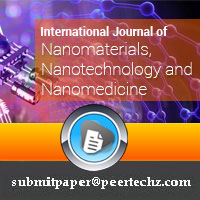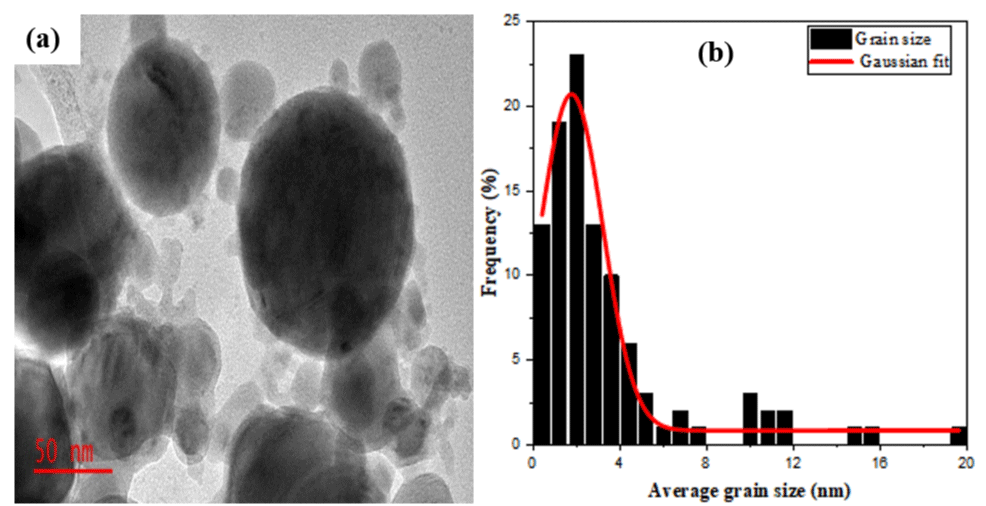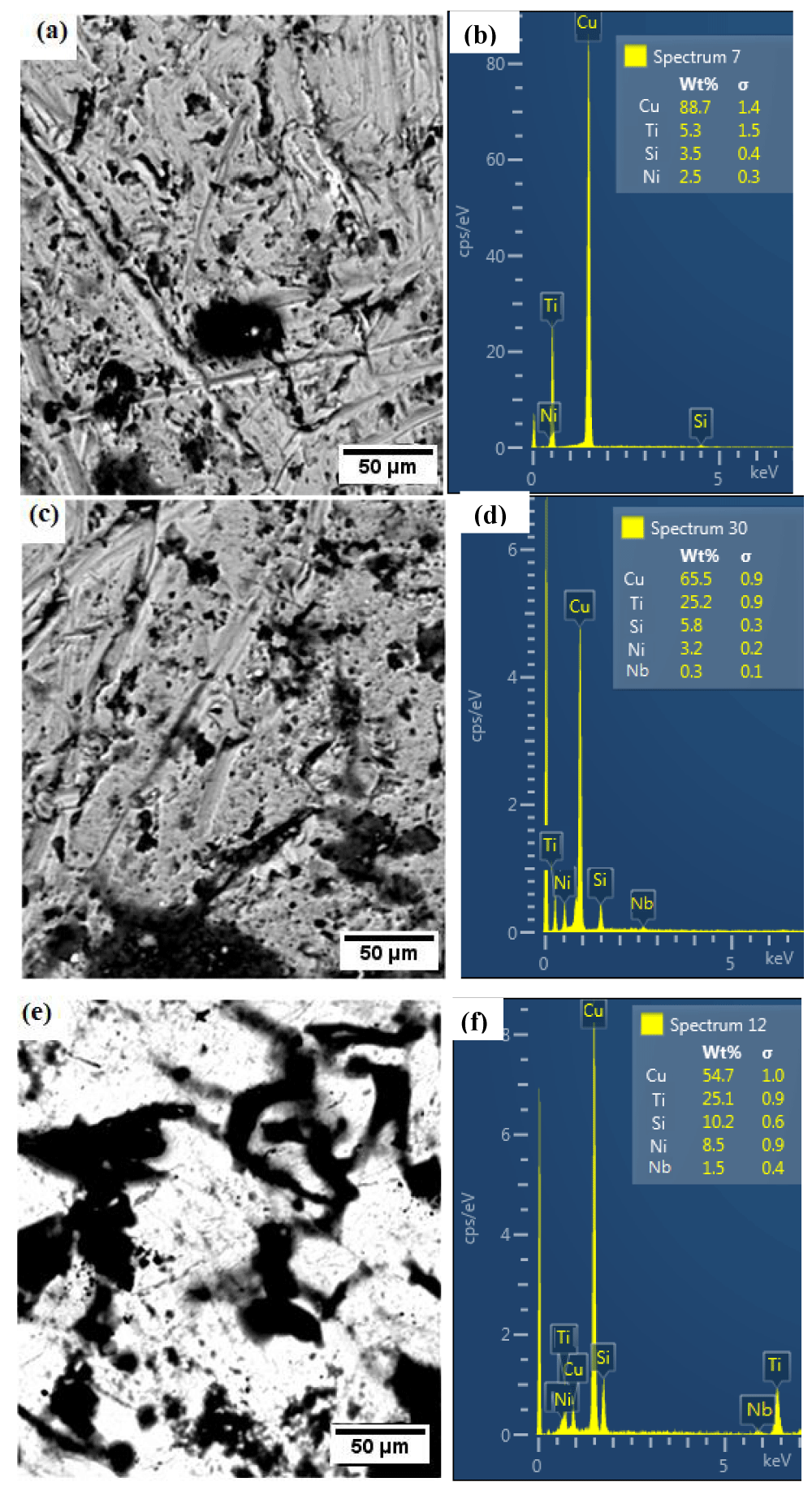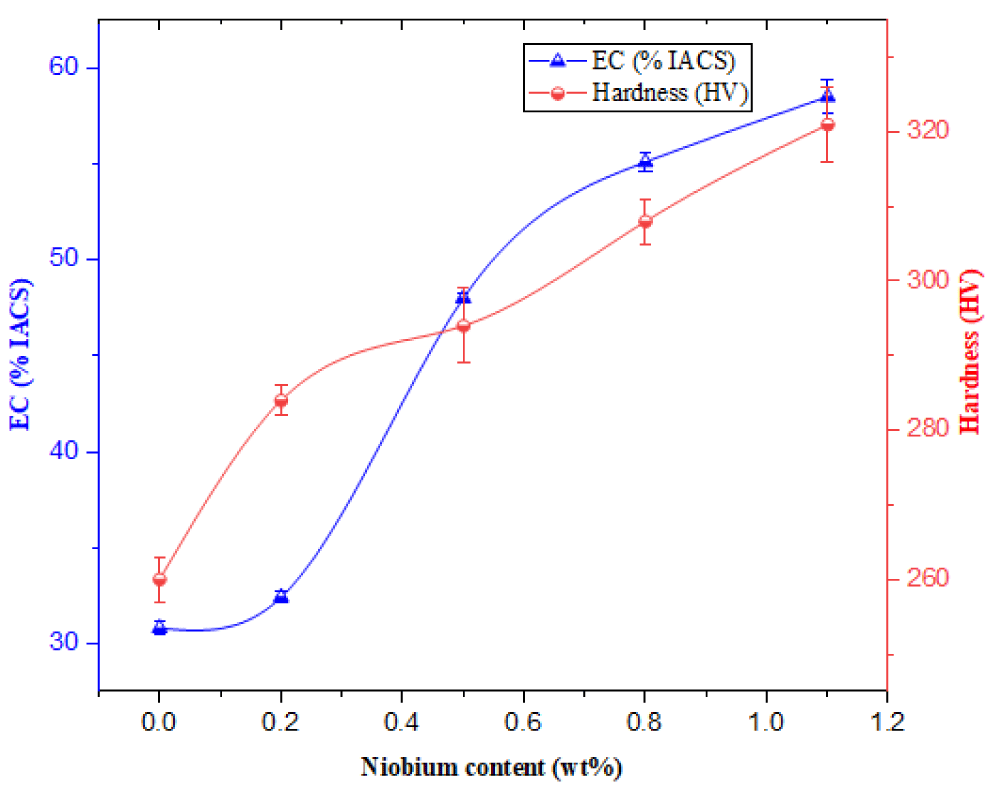International Journal of Nanomaterials, Nanotechnology and Nanomedicine
Development of High Strength and Super Electrical Conductive Cu-3Ti-2Si-1.5Ni-xNb Alloys
Kingsley C Nnakwo1*, Jeremiah L Chukwuneke2 and Paul C Okolie2
2Department of Mechanical Engineering Nnamdi Azikiwe University, Awka, Nigeria
Cite this as
Nnakwo KC, Chukwuneke JL, Okolie PC. Development of High Strength and Super Electrical Conductive Cu-3Ti-2Si-1.5Ni-xNb Alloys. Int J Nanomater Nanotechnol Nanomed. 2024;10(2):068-072. Available from: 10.17352/2455-3492.000064Copyright License
© 2024 Nnakwo KC, et al. This is an open-access article distributed under the terms of the Creative Commons Attribution License, which permits unrestricted use, distribution, and reproduction in any medium, provided the original author and source are credited.The study explored the mechanical and electrical behavior of niobium-doped Cu-3Ti-2Si-1.5Ni alloys by Scanning Electron Microscopy (SEM), Energy-Dispersive Spectroscopy (EDS), micro-Vickers hardness, and electrical conductivity tests. The stir-casted alloys underwent solution treatment at 900 °C/5 h and cooled in air. Results showed that niobium additions led to significant improvements in the properties of the parent alloy. The ultimate tensile strength, yield strength, hardness, and electrical conductivity reached maximum values of 528 MPa, 437 MPa, 358 HV, and 58.5 %IACS, respectively, at 1.1 wt% Nb addition. The enhancements were attributed to increased precipitation of second phases and refined grain structure. However, the percentage elongation decreased with niobium addition. These findings demonstrate that Cu-3Ti-2Si-1.5Ni alloys with niobium nanopowder exhibit a promising balance of mechanical and electrical performances, making them suitable for advanced engineering applications.
Introduction
The high strength and super electrical conductivity of copper alloys guaranteed their high demand in electronic, electrical, and railways for manufacturing lead frames, electrical connectors, and network cable contacts [1-5]. Cu-Be [6], Cu-Ni-Si-(Sn, Co, Ti, Mg) [7-12], Cu-Cr-(Zr, Ag) [13], Cu-Ti-Si [14], Cu-Fe-Cr [15], Cu-Co-Si [16,17], and Cu-Fe-P [18] are widely studied high strength copper alloys. These alloys gain excellent mechanical and electrical performances through solid solution strengthening, precipitation hardening, and pre-deformation. Ni-bearing phases (δ-Ni2Si and β-Ni3Si) are responsible for improvements in strength and conductivity in Cu-Ni-Si alloys.
In our earlier studies, we investigated copper-silicon alloys doped with tungsten [2], manganese [5], magnesium [19], zinc [20], titanium [21], and tin [22]. The studies demonstrated silicon bronzes (Cu-3Si) as potential materials for high-tech fields with electrical conductivity values ranging from 35.8 %IACS to 62.5 %IACS. They are known for their excellent corrosion resistance, damping capacity, wear resistance, high-temperature stability, weldability, hardness, and aesthetic appeal, hence considered for the production of fasteners, bolts, propellers, shafts, fittings, claddings, and sculptures. Tavolzhanskii, et al. [23,24] in their study obtained twin grains in Cu-Si-Mn silicon bronze via drawing and adequate annealing treatment, resulting in improvement in mechanical properties of the alloy with yield strength, tensile strength, and % strain-fracture values reaching up to 89 MPa, 242 MPa, and 83%, respectively. Filippov, et al. [25] developed recrystallized grains with high-angle boundaries in Cu-Si-Mn silicon bronze via pre-deformation and annealing treatment, leading to improvements in the ultimate tensile strength (< 350 MPa), yield strength (< 110 MPa), hardness (< 2.8 GPa), and strain-to-fracture. Asaolu, et al. [26] in their study established that the addition of nickel and pre-deformation of Cu-Si-Ni silicon bronze modified the grain, leading to an increase in strength (< 300 MPa) and hardness (< 160 MPa). Aravind, et al. [27] developed a silicon bronze with improved surface hardness, wear, and corrosion resistance via modification of grain by gas tungsten arc.
A recent study by Wang, et al. [1] noted that the incorporation of Nb in Cu-Ni-Si alloys induces rapid precipitation of the Ni2Si phase, improving the UTS (747.28 MPa), electrical conductivity (47.74%IACS), and hardness (245.9HV). Cu-Cr alloys show poor softening performance at high temperatures, hence alloyed with essential elements such as Nb, Ca, Sr, Zr, B, and Ti to improve their softening properties at high temperatures [28-31]. Nb inhibits grain growth and promotes phase stabilization in Cu-Cr alloys, leading to improvements in thermal stability at elevated temperatures, optimum tensile strength (399 MPa), percentage elongation (14.8%), and electrical conductivity (89.1%IACS) [28].
Cu-Ti alloys have robust mechanical properties achieved through diverse metallurgical processes such as solid solution, precipitation, and substructure strengthening mechanisms [32-35]. Cu-10Ni-2Si-2Ti alloy achieved maximum electrical conductivity (23.6% IACS), ultimate tensile strength (764 MPa), hardness (252.4 HV), and elongation (7.95%) through the solid solution and substructure strengthening mechanisms [33]. Wang, et al. [34] designed a high-strength Cu-Ti-Cr-Mg-Si alloy with ultimate tensile strength, elongation, and EC of 1144 MPa, 6.1%, and 24.1 %IACS, respectively by a precipitation strengthening process. In our recent study [14], we developed a Cu–3Ti–1.5Ni–0.5Si alloy with high strength (760 MPa), electrical conductivity (37.4% IACS), elongation (25.1%), and hardness (385 HV) through the aging process. Liu, et al. [36] developed Cu-3Ti-Ni alloys with an optimum strength of 147 GPa, EC of 31.32 %IACS, and hardness of 205 HV by the aging process. Cu-1.5Ti 0.5Fe recorded an improved flow stress rate (105.3 MPa) through hot deformation at 750oC, at a strain rate of 0.1/s [37]. Cu-Ti-Cr alloys attained maximum hardness (277-326 HV) and electrical conductivity (8.8-13.1 %IACS) after aging [38]. Ruixiang, et al. [39] facilitated the precipitation of coherent NiTi, Ni3Ti, and β′-Cu4Ti phases in the Cu-3Ti-2Ni alloy, achieving a peak UTS of 1133 MPa and EC of 24.2% IACS. Cao, et al. [40] developed a Cu–4Ti–1Ni alloy with a hardness value of 319.8 HV, strength of 782.2 MPa, and electrical conductivity of 15.5 IACS after the aging process. Heat treatment enhances the electrical conductivity of copper alloys by the following mechanisms: (1) dissolution of solute atoms into the matrix through the solid solution and (2) controlled precipitation of solute atoms during aging. As these solute atoms precipitate out, the concentration of solute atoms in the copper matrix decreases. This reduction in solute atom concentration decreases the number of electron scattering centers. These changes result in a material with improved electron flow and higher electrical conductivity [2,14].
From the literature reviewed, Cu-Ti-Si-Ni alloys demonstrated exceptional strength but limited electrical conductivity attributed to the solid solution mechanism. This study focuses on improving the mechanical properties and EC of Cu-Ti-Si-Ni-xNb alloys through heat treatment.
Experimental procedure
Fabrication and testing of Cu-4wt%Si and Cu-4wt%Si-xNb alloys
Cu-3Ti-2Si-1.5Ni-xNb (wt%) alloys were designed and prepared using high-purity copper rods, titanium, nickel, silicon, and niobium nanopowder (50 nm - 80 nm, 99.9% pure). The cast samples cooled inside the mold were solution-treated at 900oC/5 h and allowed to cool in air. Tensile strength, hardness, and electrical conductivity measurements were performed on three samples each, using a 100kN JPL tensile strength tester (Model: 130812), an HV-5 micro-Vickers hardness tester, and an eddy current electrical conductivity meter (EE0011) (in %IACS), respectively at room temperature. The microstructure and elemental analysis were determined on each sample using a Carl Zeiss scanning electron microscope (EVO/NA10) and Energy Dispersive Spectroscopy (EDS). Before the analyses, the samples were thoroughly ground with emery paper (400, 800, 1000, and 1200 µm), polished using a digital polishing machine with alumina powder, and etched for 30 seconds.
Results and discussions
Microstructures and elemental analysis
Figure 1 (a-b) depicts the TEM image and grain characteristics of the as-received niobium nanopowder (50-80 nm, 99.9% pure). TEM image revealed nanoscale clusters of niobium nanoparticles with an average size of 38 nm. Figure 2 (a-f) depicts the SEM microstructure and EDS spectrum of the Cu-3Ti-2Si-1.5Ni and Cu-3Ti-2Si-1.5Ni-xNb alloys. The microstructure of Cu-3Ti-2Si-1.5Ni consists of α-Cu solid solution and dendrites of copper-bearing phases. The microstructures of Cu-3Ti-2Si-1.5Ni-xNb reveal a change in grain characteristics compared with the parent alloy (Cu-3Ti-2Si-1.5Ni) with increased grain precipitations [1,28], enhancing the UTS, hardness, and electrical conductivity of the alloy. The EDS spectrum 7 (Figure 2b), presents the elemental constituents of the parent alloy (Cu-3Ti-2Si-1.5Ni). The analysis revealed Cu, Ti, Si, and Ni elements. The EDS spectra 12 and 30 in Figures 2f and 2d show the elemental composition of the parent alloy containing different concentrations of niobium (0.8 wt% and 1.1 wt%). Both spectra reveal Cu, Ti, Si, Ni, and Nb elements.
Mechanical and electrical behavior of Cu-4Si and Nb-doped-Cu-4Si alloys
Figure 3 depicts the elongation at break, yield strength (YS), and UTS of Cu-3Ti-2Si-1.5Ni and Cu-3Ti-2Si-1.5Ni-xNb alloys solution-treated and cooled in air. The Cu-3Ti-2Si-1.5Ni exhibited percentage elongation (%E), UTS, and YS values of 20.8%, 383 MPa, and 241 MPa, respectively. Cu-3Ti-2Si-1.5Ni alloys doped with various concentrations of niobium nanopowder demonstrate better tensile characteristics. The incorporation of niobium led to a decrease in the %E. The %E decreased from 20.8% to 18.4% with 0.2wt%Nb addition. The %E exhibits a decreasing trend with increasing concentrations of niobium. The UTS and YS were increased by 16.97 % and 10.37%, respectively, by 0.2wt%Nb addition. UTS and YS increased correspondingly with niobium content, recording maximum values of 528 MPa and 437 MPa, respectively, by 1.1wt% Nb addition. The improvements could be due to the precipitation of the second phase and modification of the grain structure.
Figure 4 depicts the effects of niobium nano powder additions on the hardness and electrical conductivity of Cu-3Ti-2Si-1.5Ni and Cu-3Ti-2Si-1.5Ni-xNb alloys. The Cu-3Ti-2Si-1.5Ni alloy exhibited hardness and electrical conductivity of 268 HV and 30.8 %IACS, respectively. Hardness and electrical conductivity increased by 9.23% and 5.19%, respectively, at 0.2wt% Nb nanopowder addition. The hardness increases with an increase in the concentrations of the Nb nanopowder, reaching maximum values of 358 HV and 58.5 %IACS at 1.1wt% Nb addition. More solutes precipitate out of the copper matrix at increasing concentrations of Nb, increasing the electron mean free path and the electron scattering effect in the alloy, leading to an increased electrical conductivity. The mean free path of the electrons, indicating the average distance an electron travels between collisions with atoms, increases as the number of solute atoms in the matrix decreases. The increased mean-free path results in improved electrical conductivity. With fewer solute atoms in the matrix, there is less electron scattering. Electron scattering impedes the flow of electrical current, so reducing scattering centers leads to a decrease in electrical resistivity.
The Cu-3Ti-2Si-1.5Ni-xNb alloy, with its enhanced mechanical and electrical properties, is well-suited for various high-performance applications. The increased tensile strength (UTS) and Yield Strength (YS), coupled with the fine-tuned elongation (%E) and improved hardness, make this alloy ideal for use in components that require high strength and durability, such as aerospace and automotive parts, electrical connectors, and conductive springs. The alloy's superior electrical conductivity also makes it an excellent choice for electrical and electronic applications where efficient current flow and reduced energy loss are critical.
Conclusion
The research investigated the effects of niobium nanopowder on the mechanical and electrical properties of Cu-3Ti-2Si-1.5Ni alloys, revealing significant improvements. The optimal combination of properties was achieved with a 1.1 wt% Nb addition, making these alloys suitable for applications requiring high strength, hardness, and electrical conductivity. The study found that niobium nanopowder induces grain precipitation and modifies grain structure. The Ultimate Tensile Strength (UTS) and Yield Strength (YS) increased significantly with the addition of niobium, reaching maximum values of 528 MPa and 437 MPa, respectively. However, the percentage elongation decreased with the increase in niobium content. Additionally, the hardness and electrical conductivity of the alloys improved with higher niobium content, with maximum values recorded at 358 HV and 58.5 % IACS at a 1.1 wt% Nb addition.
This work was supported by Nnamdi Azikiwe University, through the Tertiary Education Trust Fund (TETfund), Institution Based Research grant (IBR), 2023.
- Wang W, Wang J, Li S, Wang C, Zhou J, Zeng J, et al. Effects of Nb addition on the properties and microstructure of Cu-Ni-Si-Mg alloy. Mater Charact. 2022;194:112451. Available from: https://doi.org/10.1016/j.matchar.2022.112451
- Nnakwo KC. Effect of tungsten content on the structure, physical and mechanical properties of silicon bronze (Cu-3wt%Si). J King Saud Univ - Sci. 2019;31(4):844-848. Available from: https://doi.org/10.1016/j.jksus.2017.12.002
- Nam HM, Lee H, Kim H, Lee JG, Kim J. Precipitation strengthening of Cu–Ni–Si-based alloys: experimental and computational insights. J Mater Res Technol. 2023;27:5372-5379. Available from: https://doi.org/10.1016/j.jmrt.2023.11.019
- Liao X, Li L, Ren K, Jia Y, Pang Y, Xiao Z, et al. Effect of misorientation of grain boundaries on the discontinuous precipitates of Cu–Ni–Si alloy. J Mater Res Technol. 2023;26:2060-2069. Available from: https://doi.org/10.1016/j.jmrt.2023.08.056
- Nnakwo KC, Mbah CN, Daniel-Mkpume CC. Investigation of the structural sensitive behavior of Cu-3Si-xMn ternary alloys. J King Saud Univ - Sci. 2019;31(4):1056-1063. Available from: https://doi.org/10.1016/j.jksus.2019.01.001
- Mirahmadi D, Dehghani K, Shamsipur A, Kalaki A. Hot deformation behavior, microstructure evolution and processing map of Cu–2Be alloy. J Mater Res Technol. 2023;24:376-394. Available from: https://doi.org/10.1016/j.jmrt.2023.02.215
- Cao G, Zhang S, Chen J, Jia F, Fang F, Li C. Microstructure and precipitate evolution in Cu-3.2Ni-0.75Si alloy processed by twin-roll strip casting. J Mater Eng Perform. 2021;30:1318-1329. Available from: https://doi.org/10.1007/s11665-020-05371-y
- Hu J, Jiang Y, Zhao F, Liu X, Li Z, Lu C, et al. Microstructure, properties and deformation mechanism of HCCM horizontal continuous casting Cu–Ni-Co–Si alloy strip during cold rolling. J Mater Res Technol. 2023;23:5474-5485. Available from: https://doi.org/10.1016/j.jmrt.2023.02.163
- Watanabe C, Takeshita S, Monzen R. Effects of small addition of Ti on strength and microstructure of a Cu-Ni-Si alloy. Metall Mater Trans A. 2015;46:2469-2475. Available from: https://doi.org/10.1007/s11661-015-2870-z
- Lei Q, Li Z, Zhu A, Qiu W, Liang S. The transformation behavior of Cu–8.0Ni–1.8Si–0.6Sn–0.15Mg alloy during isothermal heat treatment. Mater Charact. 2011;62:904-911. Available from: https://doi.org/10.1016/j.matchar.2011.06.008
- Chenna KS, Srinath J, Jha AK, Pant B, Sharma SC, George KM. Microstructure and properties of a high-strength Cu-Ni-Si-Co-Zr alloy. J Mater Eng Perform. 2013;22:2115-2120. Available from: https://link.springer.com/article/10.1007/s11665-013-0482-6
- Wu Y, Li Y, Lu J, Tan S, Jiang F, Sun J. Effects of pre-deformation on precipitation behaviors and properties in Cu-Ni-Si-Cr alloy. Mater Sci Eng A. 2019;742:501-507. Available from: https://doi.org/10.1016/j.msea.2018.11.045
- Xu S, Fu H, Wang Y, Xie J. Effect of Ag addition on the microstructure and mechanical properties of Cu-Cr alloy. Mater Sci Eng A. 2018;726:208-214. Available from: https://doi.org/10.1016/j.msea.2018.04.077
- Nnakwo KC, Odo JU, Eweka KO, Okafor JS, Ijomah AI, Maduka EA, et al. Evaluation of the electrical conductivity and mechanical properties of Cu–3Ti–1.5Ni–0.5Si quaternary alloy. JOM. 2022;74(5):4174-4180. Available from: https://link.springer.com/article/10.1007/s11837-022-05293-1
- Yuan D, Xiao X, Chen J, Han B, Huang H, Yang B. Influence of Ag addition on the microstructure and properties of Cu-6.5Fe-0.2Cr alloy prepared by upward continuous casting. J Alloys Compd. 2021;887:161458. Available from: https://doi.org/10.1016/j.jallcom.2021.161458
- Zhao F, Lei C, Yu J, Yang H, Ling G, Liu J, et al. Effects of Co/Si atomic ratio on hardness and electrical conductivity of Cu–Co–Si alloys. Adv Eng Mater. 2023;25(1):2201241. Available from: https://doi.org/10.1002/adem.202201241
- Geng Y, Li X, Zhou H, Zhang Y, Jia Y, Tian B, et al. Effect of Ti addition on microstructure evolution and precipitation in Cu–Co–Si alloy during hot deformation. J Alloys Compd. 2020;821:153518. Available from: https://doi.org/10.1016/j.jallcom.2019.153518
- Dong Q, Shen L, Cao F, Jia Y, Liao K, Wang M. Effect of thermomechanical processing on the microstructure and properties of a Cu-Fe-P alloy. J Mater Eng Perform. 2015;24(4):1531-1539. Available from: https://link.springer.com/article/10.1007/s11665-014-1352-6
- Nnakwo KC, Mbah CN, Ude SN. Influence of chemical composition on the conductivity and some mechanical properties of Mg-doped Cu-Si alloy. J King Saud Univ - Eng Sci. 2020;32(5):287-292. Available from: https://doi.org/10.1016/j.jksues.2019.03.005
- Nnakwo KC, Osakwe FO, Ugwuanyi BC, Oghenekowho PA, Okeke IU, Maduka EA. Grain characteristics, electrical conductivity, and hardness of Zn-doped Cu–3Si alloys system. SN Appl Sci. 2021;3(11):829. Available from: https://link.springer.com/article/10.1007/s42452-021-04784-1
- Nnakwo KC, Mbah CN, Nnuka EE. Influence of trace additions of titanium on grain characteristics, conductivity and mechanical properties of copper-silicon-titanium alloys. Heliyon. 2019;5(10). Available from: https://doi.org/10.1016/j.heliyon.2019.e02471
- Nnakwo KC, Okeke IU, Nnuka EE. Structural modification and mechanical properties of Cu-3wt%Si-xwt%Sn alloy. Int J Sci Res Sci Eng Technol. 2017;3:184-187. Available from: https://www.researchgate.net/publication/327582004_Structural_Modification_and_Mechanical_Properties_of_Cu-3wtSi-xwtSn_Alloy
- Tavolzhanskii SA, Vedenkin ED, Plisetskaya IV, Bazhenov VE, Nikitina AA. Study of properties and structure of silicon bronze CuSi3Mn1 (C65500) wire at various stages of its production by continuous casting and subsequent drawing. Metallurgist. 2022;66(7–8):962-969. Available from: https://link.springer.com/article/10.1007/s11015-022-01408-w
- Filippov A, Khoroshko E, Shamarin N, Kolubaev E, Tarasov S. Study of the properties of silicon bronze-based alloys printed using electron beam additive manufacturing technology. ObrabotkaMetallov. 2023;25(1):110-130. Available from: https://cyberleninka.ru/article/n/issledovanie-svoystv-splavov-na-osnove-kremnievoy-bronzy-napechatannyh-s-primeneniem-tehnologii-elektronno-luchevogo-additivnogo
- Filippov A, Shamarin N, Moskvichev E, Savchenko N, Kolubaev E, Khoroshko E, et al. The effect of heat input, annealing, and deformation treatment on structure and mechanical properties of electron beam additive manufactured (EBAM) silicon bronze. Materials. 2022;15(9):3209. Available from: https://doi.org/10.3390/ma15093209
- Asaolu AO, Omotoyinbo JA, Oke SR, Falodun OE, Olubambi PA. Effect of nickel addition on microstructure, tensile and corrosion properties of cold rolled silicon bronze. In: Materials Today: Proceedings. 2021;38:1147-1151. Available from: https://doi.org/10.1016/j.matpr.2020.07.136
- Aravind A, Saravanan R. Improvement in hardness, wear rate and corrosion resistance of silicon bronze using gas tungsten arc. In: Materials Today: Proceedings. 2020;24:406-414. Available from: https://doi.org/10.1016/j.matpr.2020.04.292
- Guo X, Xiao Z, Qiu W, Li Z, Zhao Z, Wang X, et al. Microstructure and properties of Cu-Cr-Nb alloy with high strength, high electrical conductivity and good softening resistance performance at elevated temperature. Mater Sci Eng A. 2019;749:281-290. Available from: https://doi.org/10.1016/j.msea.2019.02.036
- Ma M, Xiao Z, Meng X, Li Z, Gong S, Dai J, et al. Effects of trace calcium and strontium on microstructure and properties of Cu-Cr alloys. J Mater Sci Technol. 2022;112:11-23. Available from: https://doi.org/10.1016/j.jmst.2021.08.080
- Peng H, Xie W, Chen H, Wang H, Yang B. Effect of micro-alloying element Ti on mechanical properties of Cu–Cr alloy. J Alloys Compd. 2021;852:157004. Available from: https://doi.org/10.1016/j.jallcom.2020.157004
- Han J, Wu Y, Zhao K, Liu S, Gao T, Liu X. Effect of boron on aging strengthened phase and properties of Cu-Cr-Zr alloy. J Mater Res Technol. 2022;19:532-541. Available from: https://doi.org/10.1016/j.jmrt.2022.05.090
- Ujah CO, Popoola P, Popoola O, Aigbodion VS, Oladijo P. Improving tribological and thermal properties of Al alloy using CNTs and Nb nanopowder via SPS for power transmission conductor. Trans Nonferrous Met Soc China. 2020;30:333-34. Available from: https://doi.org/10.1016/S1003-6326(20)65216-5
- Yang YH, Li SY, Cui ZS, Li Z, Li YP, Lei Q. Microstructure and properties of high-strength Cu–Ni–Si–(Ti) alloys. Rare Met. 2021;40(11):3251-3260. Available from: https://link.springer.com/article/10.1007/s12598-020-01699-5
- Semboshi S, Kaneno Y, Takasugi T, Masahashi N. High strength and high electrical conductivity Cu-Ti alloy wires fabricated by aging and severe drawing. Metall Mater Trans A. 2018;49:4956-4965. Available from: https://link.springer.com/article/10.1007/s11661-018-4816-8
- Wang X, Xiao Z, Qiu WT, Li Z, Liu F. The Evolution of Microstructure and Properties of a Cu–Ti–Cr–Mg–Si Alloy with High Strength during the Multi-Stage Thermomechanical Treatment. Mater Sci Eng A. 2021;803:140510. Available from: https://doi.org/10.1016/j.msea.2020.140510
- Liu J, Wang X, Ran Q, Zhao G, Zhu X. Microstructure and properties of Cu–3Ti–1Ni alloy with aging process. Trans Nonferrous Met Soc China. 2016;26(12):3183-3188. Available from: https://doi.org/10.1016/S1003-6326(16)64450-3
- Xin G, Zhou M, Jing K, Hu H, Li Z, Zhang Y, et al. Hot deformation behavior and microstructure evolution of the Cu-1.5Ti-(0.5Fe) alloys. J Mater Res Technol. 2024;30:4961-4972. Available from: https://doi.org/10.1016/j.jmrt.2024.04.208
- Markandeya R, Nagarjuna S, Sarma DS. Precipitation hardening of Cu-Ti-Cr alloys. Mater Sci Eng A. 2004;371(1–2):291-305. Available from: https://doi.org/10.1016/j.msea.2003.12.002
- Ruixiang L, Yongcheng B, Chenggang L, Wang H, Guangming C. Precipitation behavior and properties change of Cu–3Ti–2Ni alloy during aging process. Mater Sci Eng A. 2024;901:146510. Available from: https://doi.org/10.1016/j.msea.2024.146510
- Cao G, Li R, Gao Z, Li C, Wang H. Study on discontinuous precipitation behavior and performance change of Cu–Ti-Ni during aging. Philos Mag. 2023;103(24):2141-2157. Available from: https://doi.org/10.1080/14786435.2023.2270489

Article Alerts
Subscribe to our articles alerts and stay tuned.
 This work is licensed under a Creative Commons Attribution 4.0 International License.
This work is licensed under a Creative Commons Attribution 4.0 International License.





 Save to Mendeley
Save to Mendeley
